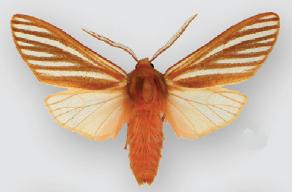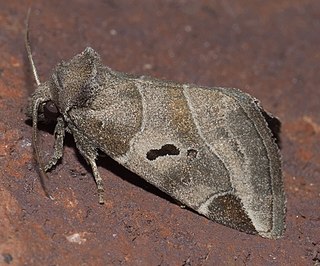
The mousebirds are birds in the order Coliiformes. They are the sister group to the clade Cavitaves, which includes the Leptosomiformes, Trogoniformes (trogons), Bucerotiformes, Piciformes and Coraciformes. This group is now confined to sub-Saharan Africa, and it is the only bird order confined entirely to that continent, with the possible exception of turacos which are considered by some as the distinct order Musophagiformes, and the cuckoo roller, which is the only member of the order Leptosomiformes, and which is found in Madagascar but not mainland Africa. Mousebirds had a wider range in the Paleogene, with a widespread distribution in Europe and North America during the Paleocene.

The Noctuidae, commonly known as owlet moths, cutworms or armyworms, are a family of moths. They are considered the most controversial family in the superfamily Noctuoidea because many of the clades are constantly changing, along with the other families of the Noctuoidea. It was considered the largest family in Lepidoptera for a long time, but after regrouping Lymantriinae, Catocalinae and Calpinae within the family Erebidae, the latter holds this title now. Currently, Noctuidae is the second largest family in Noctuoidea, with about 1,089 genera and 11,772 species. This classification is still contingent, as more changes continue to appear between Noctuidae and Erebidae.

Heliothis is a genus of moths in the family Noctuidae. It was first described by Ferdinand Ochsenheimer in 1816. Some of the species have larvae which are agricultural pests on crop species such as tobacco, cotton, soybean and pigeon pea. Some species originally in this genus have been moved to other genera, see Chloridea and Helicoverpa.

Cycnia is a genus of tiger moths in the family Erebidae. The genus was erected by Jacob Hübner in 1818.

Pseudohemihyalea is a genus of moths in the family Erebidae described by Régo Barros in 1956. While the caterpillars of most species of Pseudohemihyalea feed on broad-leaved trees, the P. ambigua group has larvae that feed on conifers. Their forewing coloration has accordingly evolved to light-and-dark lengthwise striping, giving better camouflage among the slim needles of the host plants. In this, they seem to be convergent to certain geometer moths, such as Caripeta piniata or Sabulodes niveostriata.

Alypia is a genus of moths in the family Noctuidae.

Chalcopasta is a genus of owlet moths in the family Noctuidae. There are about nine described species in Chalcopasta.
Chrysoecia is a genus of owlet moths in the family Noctuidae. There are about eight described species in Chrysoecia.

Cryphia is a genus of moths of the family Noctuidae. The genus was erected by Jacob Hübner in 1818.

Drasteria is a genus of moths in the family Erebidae.
Psectrotarsia is a small New World genus of moths of the family Noctuidae, erected in 1907 by Paul Dognin. With exception of Psectrotarsia flava, species in the genus have pink forewing markings.

Tarache is a genus of moths of the family Noctuidae erected by Jacob Hübner. It includes most former New World Acontia species. Lepidoptera and Some Other Life Forms and The Global Lepidoptera Names Index report this name as a synonym of Acontia.
Polychrysia morigera, the disjunct looper, is a moth of the family Noctuidae. The species was first described by Henry Edwards in 1886. In the east of North America, it is found in the Mississippi, Missouri, and Ohio river valleys from Pennsylvania to Tennessee. In the Rocky Mountains it is found from Montana to Colorado and on the west coast it occurs from Oregon to northern California. It is the rarest of the North American Plusiinae species.
Euros osticollis is a moth of the family Noctuidae. It is found along streams and seeps in south-western Oregon.
Euros cervina is a moth of the family Noctuidae described by Henry Edwards in 1890. It is found in riparian areas in the United States in western Oregon and northern California.
Marimatha quadrata is a moth of the family Noctuidae first described by Clifford D. Ferris and J. Donald Lafontaine in 2010. It is found from western Texas and Arizona and southward to southern Mexico (Sinaloa).

Stiriinae is a subfamily of owlet moths in the family Noctuidae. There are more than 20 genera and 130 described species in Stiriinae.

Ichneutica omicron is a species of moth in the family Noctuidae. It is endemic to New Zealand and found only in the middle and lower parts of the North Island. It is very similar in appearance to its sister species Ichneutica barbara. The life history of this species is unknown as are the host species of the larvae. The adults are on the wing in November and December. This species is classified as "At Risk, Naturally Uncommon" by the Department of Conservation.

Ichneutica blenheimensis is a species of moth in the family Noctuidae. It is endemic to New Zealand and is found throughout the North, South and the Stewart Islands. This species appears to prefer drier eastern localities and is rarely collected in western North Island forested areas. It does not appear to be frequently collected in inland dry tussock grassland habitats. The host plant for the larvae of this species is likely to be the golden sand sedge pīngao which is now absent from the moths type locality. However Chappell has raised very young larvae on grass species and the more developed larvae consumed Phormium tenax. Adults are on the wing from November to March and are attracted to both light and sugar traps. The blackish forewing fringes are diagnostic of this species. But worn specimens of I. arotis can be confused with worn specimens of I. blenheimensis. However I. arotis can be distinguished from I. blenheimensis as it has a scale-tuft on the thorax and dark longitudinal stripes on the tegula. This species is classified as "At Risk, Naturally Uncommon" by the Department of Conservation.












